Financial Statements: Working Capital
Tan KW
Publish date: Sun, 14 Jul 2013, 07:30 PM
By David Harper
(Contact David)
A recurring theme in this series is the importance of investors shaping their analytical focus according to companies' business models. Especially when time is limited, it's smart to tailor your emphasis so it's in line with the economic drivers that preoccupy the company's industry. It's tough to get ahead of the "investing pack" if you are reacting to generic financial results - such as earnings per share(EPS) or revenue growth - after they've already been reported. For any given business, there are usually some key economic drivers, or leading indicators, that capture and reflect operational performance and eventually translate into lagging indicators such as EPS. For certain businesses, trends in the working capital accounts can be among these key leading indicators of financial performance.
Where is Working Capital Analysis Most Critical?
On the one hand, working capital is always significant. This is especially true from the lender's or creditor's perspective, where the main concern is defensiveness: can the company meet its short-term obligations, such as paying vendor bills?
But from the perspective of equity valuation and the company's growth prospects, working capital is more critical to some businesses than to others. At the risk of oversimplifying, we could say that the models of these businesses are asset or capital intensive rather than service or people intensive. Examples of service intensive companies include H&R Block, which provides personal tax services, and Manpower, which provides employment services. In asset intensive sectors, firms such as telecom and pharmaceutical companies invest heavily in fixed assets for the long term, whereas others invest capital primarily to build and/or buy inventory. It is the latter type of business - the type that is capital intensive with a focus on inventory rather than fixed assets - that deserves the greatest attention when it comes to working capital analysis. These businesses tend to involve retail, consumer goods and technology hardware, especially if they are low-cost producers or distributors.
Working capital is the difference between current assets and current liabilities:
 |
Inventory
Inventory balances are significant because inventory cost accounting impacts reported gross profit margins. (For an explanation of how this happens, see Inventory Valuation For Investors: FIFO and LIFO.) Investors tend to monitor gross profit margins, which are often considered a measure of the value provided to consumers and/or the company's pricing power in the industry. However, we should be alert to how much gross profit margins depend on the inventory costing method.
Below we compare three accounts used by three prominent retailers: net sales, cost of goods sold(COGS) and the LIFO reserve.
 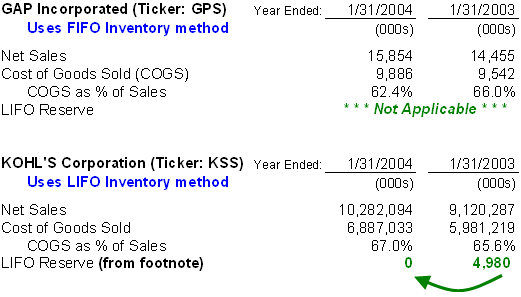 |
Walgreen's represents our normal case and arguably shows the best practice in this regard: the company uses LIFO inventory costing, and its LIFO reserve increases year over year. In a period of rising prices, LIFO will assign higher prices to the consumed inventory (cost of goods sold) and is therefore more conservative. Just as COGS on the income statement tends to be higher under LIFO than under FIFO, the inventory account on the balance sheet tends to be understated. For this reason, companies using LIFO must disclose (usually in a footnote) a LIFO reserve, which when added to the inventory balance as reported, gives the FIFO-equivalent inventory balance.
Because GAP Incorporated uses FIFO inventory costing, there is no need for a "LIFO reserve." However, GAP's and Walgreen's gross profit margins are not commensurable. In other words, comparing FIFO to LIFO is not like comparing apples to apples. GAP will get a slight upward bump to its gross profit margin because its inventory method will tend to undercount the cost of goods. There is no automatic solution for this. Rather, we can revise GAP's COGS (in dollar terms) if we make an assumption about the inflation rate during the year. Specifically, if we assume that the inflation rate for the inventory was R% during the year, and if "Inventory Beginning" in the equation below equals the inventory balance under FIFO, we can re-estimate COGS under LIFO with the following equation:
Kohl's Corporation uses LIFO, but its LIFO reserve declined year over year - from $4.98 million to zero. This is known as LIFO liquidation or liquidation of LIFO layers, and indicates that during the fiscal year, Kohl's sold or liquidated inventory that was held at the beginning of the year. When prices are rising, we know that inventory held at the beginning of the year carries a lower cost (because it was purchased in prior years). Cost of goods sold is therefore reduced, sometimes significantly. Generally, in the case of a sharply declining LIFO reserve, we can assume that reported profit margins are upwardly biased to the point of distortion.
Cash Conversion Cycle
The cash conversion cycle is a measure of working capital efficiency, often giving valuable clues about the underlying health of a business. The cycle measures the average number of days that working capital is invested in the operating cycle. It starts by adding days inventory outstanding (DIO) to days sales outstanding (DSO). This is because a company "invests" its cash to acquire/build inventory, but does not collect cash until the inventory is sold and the accounts receivable are finally collected.
Receivables are essentially loans extended to customers that consume working capital; therefore, greater levels of DIO and DSO consume more working capital. However, days payable outstanding(DPO), which essentially represent loans from vendors to the company, are subtracted to help offset working capital needs. In summary, the cash conversion cycle is measured in days and equals DIO + DSO – DPO:
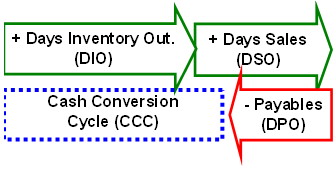 |
Here we extracted two lines from Kohl's (a retail department store) most recent income statement and a few lines from their working capital accounts.
 |
Circled in green are the accounts needed to calculate the cash conversion cycle. From the income statement, you need net sales and COGS. From the balance sheet, you need receivables, inventories and payables. Below, we show the two-step calculation. First, we calculate the three turnover ratios: receivables turnover (sales/average receivables), inventory turnover (COGS/average inventory) and payables turnover (purchases/average payables). The turnover ratios divide into an average balance because the numerators (such as sales in the receivables turnover) are flow measures over the entire year.
Also, for payables turnover, some use COGS/average payables. That's okay, but it's slightly more accurate to divide average payables into purchases, which equals COGS plus the increase in inventory over the year (inventory at end of year minus inventory at beginning of the year). This is better because payables finance all of the operating dollars spent during the period (that is, they are credit extended to the company). And operating dollars, in addition to COGS, may be spent to increase inventory levels.
The turnover ratios do not mean much in isolation; they are used to compare one company to another. But if you divide the turnover ratios into 365 (for example, 365/receivables turnover), you get the "days outstanding" numbers. Below, for example, a receivable turnover of 9.6 becomes 38 days sales outstanding (DSO). This number has more meaning; it means that, on average, Kohl's collects its receivables in 38 days.
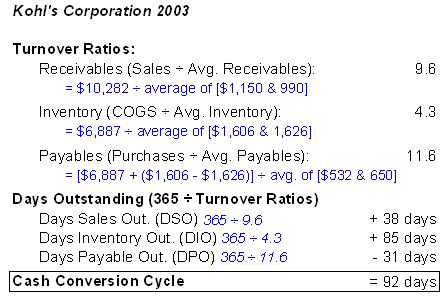 |
Here is a graphic summary of Kohl's cash conversion cycle for 2003. On average, working capital spent 92 days in Kohl's operating cycle:
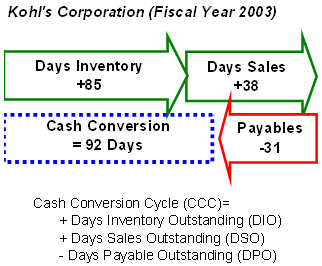 |
Let's contrast Kohl's with Limited Brands. Below we perform the same calculations in order to determine the cash conversion cycle for Limited Brands:
 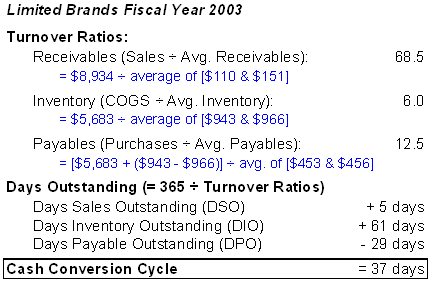 |
But even better, the year over year trend in the cash conversion cycle often serves as a sign of business health or deterioration. Declining DSO means customers are paying sooner; conversely, increasing DSO could mean the company is using credit to push product. A declining DIO signifies that inventory is moving out rather than "piling up." Finally, some analysts believe that an increasing DPO is a signal of increasing economic leverage in the marketplace. The textbook examples here are Walmart and Dell: these companies can basically dictate the terms of their relationships to their vendors and, in the process, extend their days payable (DPO).
Looking "Under the Hood" for Other Items
Most of the other working capital accounts are straightforward, especially the current liabilities side of the balance sheet. But you do want to be on the alert for the following:
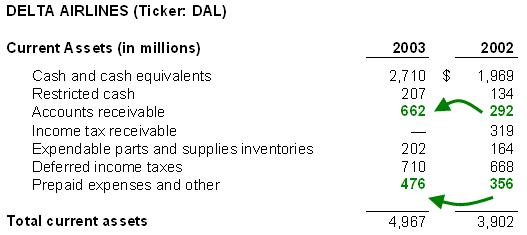 |
Notice that Delta's receivables more than doubled from 2002 to 2003. Is this a dangerous sign of collections problems? Let's take a look at the footnote:
We were party to an agreement, as amended, under which we sold a defined pool of our accounts receivable, on a revolving basis, through a special-purpose, wholly owned subsidiary, which then sold an undivided interest in the receivables to a third party.... This agreement terminated on its scheduled expiration date of March 31, 2003. As a result, on April 2, 2003, we paid $250 million, which represented the total amount owed to the third party by the subsidiary, and subsequently collected the related receivables. (Note 8, Delta 10-K FY 2003)
Here's the translation: during 2002, most of Delta's receivables were factored in an off-balance sheet transaction. By factored, we mean Delta sold some of its accounts receivables to another company (via a subsidiary) in exchange for cash. In brief, Delta gets paid quickly rather than having to wait for customers to pay. However, the seller (Delta in this case) typically retains some or all of the credit risk - the risk that customers will not pay. For example, they may collateralize the receivables.
We see that during 2003, the factored receivables were put back onto the balance sheet. In economic terms, they never really left but sort of disappeared in 2002. So the 2003 number is generally okay, but there was not a dramatic jump. More importantly, if we were to analyze year 2002, we'd have to be sure to manually "add-back" the off-balance sheet receivables, which would otherwise look artificially favorable for that year.
We also highlighted Delta's increase in "prepaid expenses and other" because this innocent-looking account contains the fair value of Delta's fuel hedge derivatives. Here's what the footnote says:
Prepaid expenses and other current assets increased by 34%, or $120 million, primarily due to an increase in prepaid aircraft fuel as well as an increase in the fair value of our fuel hedge derivative contracts.... Approximately 65%, 56% and 58% of our aircraft fuel requirements were hedged during 2003, 2002 and 2001, respectively. In February 2004, we settled all of our fuel hedge contracts prior to their scheduled settlement dates… and none of our projected aircraft fuel requirements for 2005 or thereafter.
The rules concerning derivatives are complex, but the idea is this: it is entirely likely that working capital accounts contain embedded derivative instruments. In fact, the basic rule is that, if a derivative is a hedge whose purpose is to mitigate risk (as opposed to a hedge whose purpose is to speculate), then the value of the hedge will impact the carrying value of the hedged asset. For example, if fuel oil is an inventory item for Delta, then derivatives contracts meant to lock-in future fuel oil costs will directly impact the inventory balance. Most derivatives, in fact, are not used to speculate but rather to mitigate risks that the company cannot control.
Delta's footnote above has good news and bad news. The good news is that as fuel prices rose, the company made some money on its fuel hedges, which in turn offset the increase in fuel prices - the whole point of their design! But this is overshadowed by news which is entirely bad: Delta settled "all of [their] fuel hedge contracts" and has no hedges in place for 2005 and thereafter! Delta is thus exposed in the case of high fuel prices, which is a serious risk factor for the stock.
Summary
Traditional analysis of working capital is defensive; it asks, "Can the company meet its short-term cash obligations?" But working capital accounts also tell you about the operational efficiency of the company. The length of the cash conversion cycle (DSO+DIO-DPO) tells you how much working capital is tied up in ongoing operations. And trends in each of the days-outstanding numbers may foretell improvements or declines in the health of the business.
Investors should check the inventory costing method, and LIFO is generally preferred to FIFO. However, if the LIFO reserve drops precipitously year over year, then the implied inventory liquidation distorts COGS and probably renders the reported profit margin unusable.
Finally, it's wise to check the current accounts for derivatives (or the lack of them, when key risks exist) and off-balance sheet financing.
http://www.investopedia.com/university/financialstatements/financialstatements6.asp





















